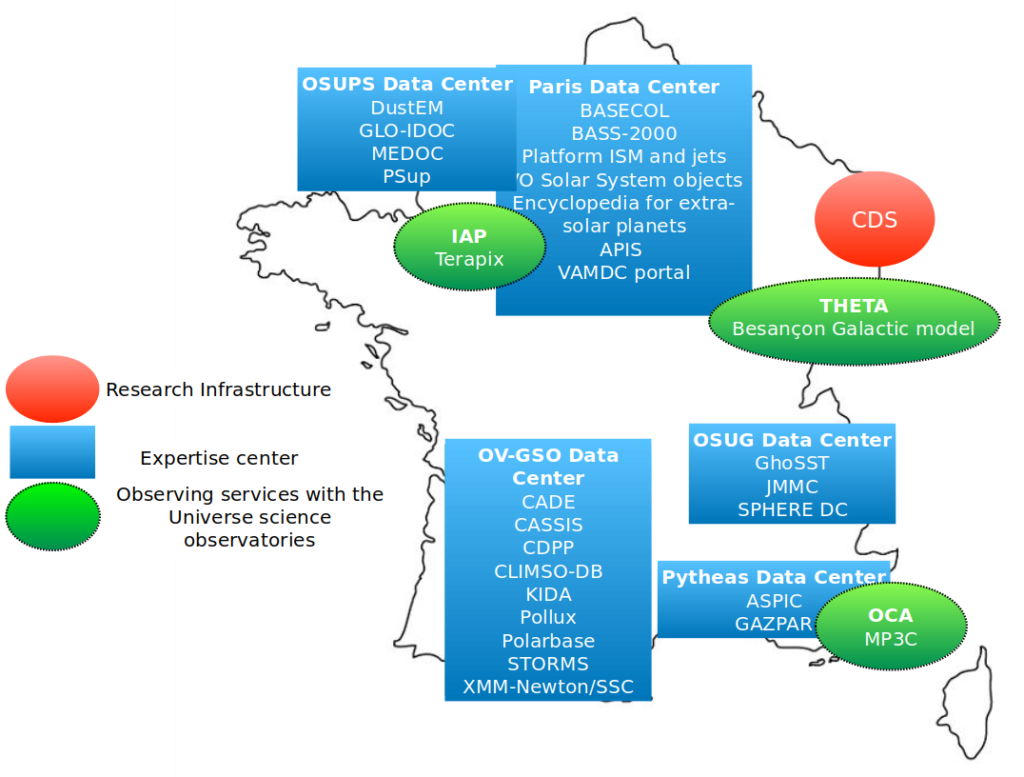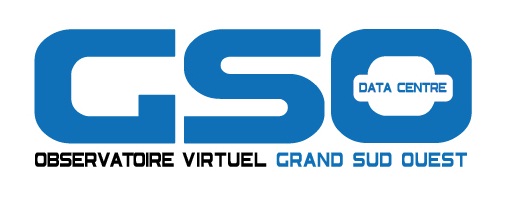
of astrophysical data in France. OV-GSO covers the whole south-west area
CADE
CADE (http://cade.irap.omp.eu/) is an analysis center for extended data. It provides maps of ancillary astronomical data to users in the astronomical community. The emphasis of CADE is on extended sky emission. The database is provided in the HEALPix sky pixelization scheme. CADE pursues a strategy of ancillary data ingestion in the HEALPix format, generating partial or all-sky HEALPix files from astronomical data that is represented using the more traditional local World Coordinate System (WCS) FITS format (Paradis et al. (2012)). This method guarantees the photometric accuracy of the transformation with minimal data loss during the transformation. CADE provides astronomical data production in the HEALPix format, data archiving and diffusion to the community.
CASSIS
CASSIS (http://cassis.irap.omp.eu/) started in 2005 and is an interactive spectrum analyzer that was originally proposed for the scientific exploitation of (far-infrared and submillimetric) data from the Herschel Space Observatory. CASSIS allows users to visualize observed or synthetic spectra, together with a line identification tool. It can also predict spectra which may be observed by any (single-dish, so far) telescope. Comparison between observations and synthetic spectra is also possible with the same tool (see Vastel et al. (2015)). CASSIS is now evolving towards a multi-purpose spectral analysis tool, operating beyond its initial range of application.
CDPP
The CDPP (http://cdpp.irap.omp.eu/) is the french national data center of expertise concerning terrestrial and planetary plasma data. It was created in 1998 by CNRS/INSU and the French space agency CNES. It assures the long term preservation of data obtained primarily from instruments built using French resources, and renders them readily accessible and exploitable by the international community. The CDPP also provides services to enable online data analysis (AMDA, see amda.cdpp.eu), and 3D data visualization in context (3DView, see 3dview.cdpp.eu). The CDPP also plays an important role in the development of interoperability standards (see e.g., Génot et al.(2014)).
CLIMSO-DB
CLIMSO (http://climso.irap.omp.eu/) stands for Christian Latouche IMageur Solaire. CLIMSO is an astronomical observation instrument at Pic du midi observatory in the Pyrénées (France) specialized in the study of the Sun. It makes multiple films of the sun, particularly the globality of the surface and corona. The aim of this instrument is to study the course of the dynamic phenomena in the solar atmosphere by taking into account the great heterogeneity in temperatures, densities, magnetic and electric properties of these areas. It thus acts as a total diagnostic of the solar activity (simultaneously cold corona, hot corona, surface events). It provides images via the French ground solar data BASS2000.
KIDA
KIDA (http://kida.obs.u-bordeaux1.fr/) is a database of kinetic data of interest for astrochemical (interstellar medium and planetary atmospheres) studies. In addition to the available referenced data, KIDA provides recommendations over a number of important reactions. Chemists and physicists can also add their own data to the database. KIDA also distributes a code, named Nahoon, to study the time-dependent gas-phase chemistry of 0D and 1D interstellar sources. Details about the KIDA database can be found in Wakelam et al. (2012).
Polarbase
PolarBase (http://polarbase.irap.omp.eu/) is a database of high resolution spectropolarimetric stellar observations. It was officially opened to the public in 2013. This service distributes high resolution optical stellar spectra from the Espadons at CFHT and Narval at TBL spectropolarimeters. Reduced spectra, in various Stokes parameters, are delivered to the community, as well as standardized extracted polarized signatures. A complete description of the database can be found in Petit et al. (2014).
Pollux
Pollux (http://pollux.oreme.org/) is a stellar spectra database, developed at the Laboratoire Univers et Particules de Montpellier, giving access to theoretical data. For that purpose, high resolution synthetic spectra have been computed using the best available models of atmosphere (CMFGEN, ATLAS and MARCS), high-quality spectral synthesis codes (CMF FLUX, SYNSPEC and TURBOSPECTRUM), atomic line lists from VALD database, and specific molecular line lists for cool stars are provided. Spectral types from O to M are represented for a large set of fundamental parameters: Teff, log(g), [Fe/H], and specific abundances (Palacios et al. 2010).
SCC-XMM
The XMM-Newton Survey Science Centre (http://xmmssc.irap.omp.eu/) produces catalogs of all X-ray sources detected with the satellite launched in 1999. The SSC has responsibilities within the XMM-Newton project in four main areas: compilation of the Serendipitous Source Catalogue, follow-up/identification program for the serendipitous X-ray sky survey (XID Programme), pipeline processing of all XMM-Newton observations, development of science analysis software for XMM-Newton.
STORMS
STORMS (https://storms-service.irap.omp.eu/), which stands for Solar Terrestrial ObseRvations and Modeling Service, is a public service providing tools and data to perform studies in heliophysics and space weather, and to study and model the influence of solar activity on the geospace environment, as well as on planets or any other solar system bodies (comets, asteroids or spacecrafts).The main tool it provides so far, propagationtool.cdpp.eu, was jointly developed with CDPP. It is meant for the tracking of solar storms, streams and energetic particles in the heliosphere.
